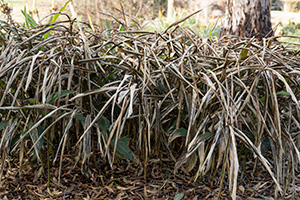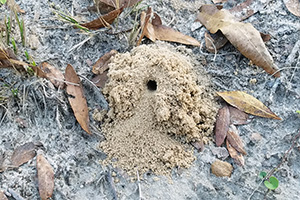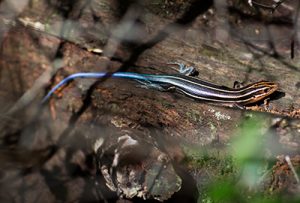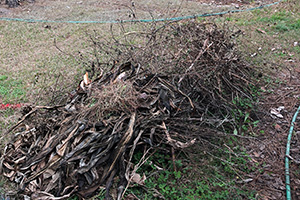Wildlife-Friendly Winter Gardens
Even with our mild winters, some plants experience a dormant period where they appear dried and brown. There is a tendency to cut back these plants, but the branches, stems, leaves, and seed pods provide habitat and food during the winter for many wildlife species. This plant material supports pollinators and beneficial insects by creating spaces for refuge.
Before “tidying up” your garden this winter, consider the benefits in allowing natural processes to take course. Retaining leaf litter and other plant materials can provide nesting and overwintering habitat for wildlife.
Save the Stems

The hollow stems of dead or dormant plants can serve as nesting chambers for insects, so waiting to prune until late spring or summer is recommended. Small carpenter bees (Ceratina spp.) often create nests in wildflower stems, and some moths and spiders are known occupants as well.
When you do eventually prune, leave the stems on the ground to give nesting insects time to emerge. You can also toss them in a mulch or compost pile. Cut the plants at varying heights from 8 to 24 inches tall, which creates vertical nesting communities suitable for insects of different sizes. Consider leaving wildflowers and their seed heads intact over the winter, for the seeds serve as food for birds.
Leave the Leaves
Fallen leaves are a safe haven for many creatures. During the winter, many moths and butterflies rely on leaf litter to protect their eggs, caterpillars, and chrysalises. Other species that live or overwinter in leaves include lace bugs, snails, worms, beetles, millipedes, spiders, and more.

You can leave a thin layer of leaves on any lawn area or spread them over vegetables and flower beds to build soil and provide habitat. It can serve as mulch for ornamental trees, shrubs, and perennials to help retain moisture and suppress weeds.
Allowing fallen leaves to stay where they land, or redistributing them to other parts of your yard, can greatly benefit not only insects but the wildlife that feeds on them such as birds. If you decide to remove the leaves from your landscape, consider waiting until late spring to allow butterflies and other insects to emerge successfully.
Allow for Access to Soil

Many pollinators, like some ground-dwelling bees, nest in accessible soil, so it helps to leave some areas of your yard with little to no mulch or turfgrass. Thin layers of leaves such as pine needles add some habitat without crowding out the soil and allow for nesting to occur. The nests appear as small sandy mounds with a circular hole in the center. Leave the mounds undisturbed so that the bees may emerge. These ground-nesting bees are usually solitary and are not aggressive towards people or pets.
Keep the Logs

Logs and snags (dead trees or stumps) serve a purpose in nature as burrowing chambers for insects and habitat for woodpeckers and owls. So instead of seeing these tree segments as an eyesore, think of them as a bird house or even a beneficial-bug hotel. As long as a snag does not pose any danger, it can be left to its own devices and support your backyard ecosystem as it decays. Fallen logs provide moist spaces underneath for spiders and beetles, while the drier parts provide nesting and overwintering habitat for bees and butterflies. Frogs are attracted to the moisture of heavily decomposed logs, and lizards use logs to bask in the sun.
Create Brush Piles

Instead of having your curbside brush hauled off by the local waste management authority, consider creating “brush piles” in your landscape to provide habitat for wildlife. Brush piles serve as hibernation sites for butterflies, shelter for fireflies, nesting habitat for wild bees, and food for wood-eating beetles and other organisms that help break down the organic matter. Small mammals also create burrows beneath the brush and some birds find refuge in them. To create a brush pile, place larger branches on the bottom to create a sturdy base and then continue stacking branches and logs crosswise with smaller limbs on top. They can be placed in an out-of-the-way location such as near a woodland edge or fence. You can hide the pile behind a hedge or wildflowers if you are concerned about appearance, or simply create a “pollinator habitat” sign to indicate your intentions.
Create Rock Piles or Rock Walls
Another way to support wildlife is to build a rock pile or rock wall, which provides cracks and crevices for beneficial insects to nest or seek shelter. When building a rock pile, use a range of different sizes and types to leave plenty of air space, and consider planting wildflowers nearby to make it more attractive to pollinators. When building a rock wall, make sure you leave crevices for shelter.
When making plans for your winter garden, you can incorporate these wildlife-friendly practices to support local pollinators and other species. Instead of pruning back and cleaning out dead plant matter, you can help nature work its magic by leaving or redistributing what’s already there, providing habitat and protection for wildlife. Sometimes just letting nature take its course is the best mode of action for a healthy ecosystem and garden.
Also on Gardening Solutions
- Creating Wildlife Habitats with Dead Wood
- Designing a Habitat Garden
- How Can My Yard Contribute to Community Ecology?
